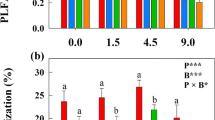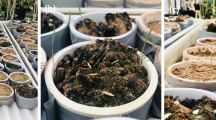Abstract
The relationships between bryophyte biomass and species richness and soil pH, nutrient applications and vascular plant biomass and species richness were analyzed for the Park Grass Experiment (Rothamsted, UK). The study examined the abundance of bryophytes in relation to long-term fertilizer and lime application and to fertilizer treatments recently being ceased on some plots. The probability of bryophytes being present on a plot increased with increasing soil pH, and on plots at soil pH 3.3–4.5, the lowest values in this experiment, there were virtually no mosses present. Total bryophyte biomass decreased with increasing vascular plant biomass and vascular plant richness. Both bryophyte biomass and species richness showed a curvilinear response to soil pH. Bryophyte biomass was markedly increased on plots where nitrogen (N) fertilization had recently been ceased. The abundance of the common bryophyte species showed individualistic responses to treatments. N had a negative effect on the abundance of Brachythecium rutabulum. Increasing soil pH, and the application of phosphorus (P) and potassium (K) fertilizer together, had a positive effect on Eurhynchium praelongum. This species was also negatively affected by N, but tolerated larger amounts of it (100–150 kg ha−1 N) than B. rutabulum. An ephemeral moss, Bryum subapiculatum, had a unimodal response to soil pH but showed no response to N, P, K or other explanatory variables.
Similar content being viewed by others
References
Al-Mufti, M. M., Sydes, C. L., Furness, S. B., Grime, J. P., & Band, S. R. 1977. A quantitative analysis of shoot phenology and dominance in herbaceous vegetation. J. Ecol. 65: 759–791.
Bakken, S. 1994. Growth and nitrogen dynamics of Dicranum majus under two contrasting nitrogen deposition regimes. Lindbergia 19: 63–72.
Bates, J. W. 1992. Mineral nutrient acquisition and retention by bryophytes. J. Bryol. 17: 223–232.
Bates, J. W. 1994. Responses of the mosses Brachythecium rutabulum and Pseudoscleropodium purum to a mineral nutrient pulse. Funct. Ecol. 17: 223–232.
Blockeel, T. L. & Long, D. G. 1998. A check-list and census catalogue of British and Irish Bryophytes. British Bryological Society, Cardiff.
Brown, D. H. 1992. Impact of agriculture on bryophytes and lichens. Pp. 259–283. In: Bates, J.W. & Farmer, A. M. (eds), Bryophytes and lichens in a changing environment. Clarendon Press, Oxford.
Büscher, P., Koedam, N. & van Speybroeck, D. 1990. Cation-exchange properties and adaptation to soil acidity in bryophytes. New Phytol. 115: 177–186.
Common, T. G., Hunter, E. A., Floate, J. S., Eadie, J. & Hodgson, J. 1991. The long-term effects of a range pasture treatments applied to three semi-natural hill grassland communities. 1. Pasture production and botanical composition. Grass Forage Sci. 46: 239–251.
Carson, W. P. & Pickett, S. T. A. 1990. Role of resources and disturbance in the organization of an old-field plant community. Ecology 71: 226–338.
Cornish, M.W. 1954. The origin and structure of grassland types of the central North Downs. J. Ecol. 42: 359–374.
Crawley, M. J. 1993. GLIM for ecologists. Blackwell Science, Oxford.
Crawley, M. J. 1997. Plant ecology, 2nd ed. Blackwell Science, Oxford.
Dirkse, G. M. & Martakis, G. F. P. 1992. Effects of fertilizer on bryophytes in Swedish experiments on forest fertilization. Biol. Cons. 59: 155–161.
Dodd, M. E., Silvertown, J., McConway, K., Potts, J., Crawley, M. 1994. Application of the British National Vegetation Classification to the communities of the Park Grass Experiment through time. Folia Geobot. Phytotax. 29: 321–334.
Dodd, M., Silvertown, J., McConway, K., Potts, J. & Crawley, M. 1995. Community stability: a 60-year record of trends and outbreak in the occurrence of species in the Park Grass Experiment. J. Ecol. 83: 277–285.
During, H. J. 1979. Life strategies of bryophytes: a preliminary review. Lindbergia 5: 2–18.
During, H. J. 1990. The bryophytes of calcareous grasslands. Pp. 35–40. In: Hillier, S. H., Walton, D. W. H. & Wells, D. A. (eds), Calcareous grasslands-ecology and management. Bluntisham Books, Bluntisham.
During, H. J. 1992. Ecological classifications of bryophytes and lichens. Pp. 1–31. In: Bates, J. W. & Farmer, A. M. (eds), Bryophytes and lichens in a changing environment. Clarendon Press, Oxford.
During, H. J. & Lloret, F. 1996. Permanent grid studies in bryophyte communities. 1. Pattern and dynamics of individual species. J. Hatt. Bot. Lab. 79: 1–41.
During, H. J. & ter Horst, B. 1983. The diaspore bank of bryophytes and ferns in chalk grassland. Lindbergia 9: 57–64.
During, H. J. & Willems, J. H. 1986. The impoverishment of the bryophyte and lichen flora of the Dutch chalk grasslands in the thirty years 1953-1983. Biol. Cons. 36: 143–158.
Farmer, A. M., Bates, J. W. & Bell, J. N. B. 1992. Ecophysiological effects of acid rain on bryophytes and lichens. Pp. 286–313. In: Bates, J. W. & Farmer, A. M. (eds), Bryophytes and lichens in a changing environment. Clarendon Press, Oxford.
Finér, L. & Braekke, F. H. 1991. Understorey vegetation on three ombrotrophic pine bogs and the effects of NPK and PK fertilization. Scand. J. For. Sci. 6: 113–128.
Grime, J. P. 1979. Plant strategies and vegetation processes. John Wiley, New York.
Herben, T. 1994. The role of reproduction for persistence of bryophyte populations in transient and stable habitats. J. Hatt. Bot. Lab. 76: 115–126.
Huntley, B., Baxter, R., Lewthwaite, K. J., Willis, S. G. & Adamson, J. K. 1998. Vegetation responses to local climatic changes induced by a water-storage reservoir. Global Ecol. Biog. Lett. 7: 241–257.
Hutchinson, T. C. & Scott, M. G. 1988. The response of the feather moss, Pleurozium schreberi, to 5 years of simulated acid precipitation in the Canadian boreal forest. Can. J. Bot. 66: 82–88.
Ingerpuu, N., Kull, K. & Vellak, K. 1998. Bryophyte vegetation in a wooded meadow: relationships with phanerogam diversity and responses to fertilization. Plant Ecol. 134: 163–171.
Jäppinen, J.-P. & Hotanen, J.-P. 1990. Effect of fertilization on the abundance of bryophytes in two drained peatland forests in Eastern Finland. Ann. Bot. Fenn. 27: 93–108.
John, E. & Turkington, R. 1995. Herbaceous vegetation in the understorey of the boreal forest: does nutrient supply or snowshoe hare herbivory regulate species composition and abundance? J. Ecol. 83: 581–590.
Johnston, A. E., Goulding, K.W. T. & Poulton, P. R. 1986. Soil acidification during more than 100 years under permanent grassland and woodland at Rothamsted. Soil Use Manag. 2: 3–10.
Kellner, O. 1993. Effects on associated flora of sylvicultural nitrogen fertilization repeated at long intervals. J. Appl. Ecol. 27: 563–574.
Longton, R. E. 1984. The role of bryophytes in terrestrial ecosystems. J. Hatt. Bot. Lab. 55: 147–163.
McCullagh, P. & Nelder, J. A. 1989. Generalized linear models. Chapman and Hall, London.
Mickiewicz, J. 1976. Influence of mineral fertilization on the biomass of moss. Pol. Ecol. Stud. 2: 57–62.
Payne, C. D. 1986. The GLIM System Release 3.77 Manual. Numerical Algorithms Group. Royal Statistical Society, Oxford.
Rodwell, J. S. 1992. British plant communities, Vol. 3. Grasslands and montane communities. Cambridge University Press, Cambridge.
Silvertown, J. 1980. The dynamics of a grassland ecosystem: botanical equilibrium in the Park Grass Experiment. J. Appl. Ecol. 17: 491–504.
Silvertown, J., Dodd, M. E., McConvay, K., Potts J. & Crawley M. J. 1994. Rainfall, biomass variation and community composition in the Park Grass Experiment. Ecology 75: 2430–2437.
Smith, A. J. E. 1978. The moss flora of Britain and Ireland. Cambridge University Press, Cambridge.
Smith, A. J. E. 1990. The liverworts of Britain and Ireland. Cambridge University Press, Cambridge.
Snaydon, R.W. 1962. Micro-distribution of Trifolium repens L. and its relation to soil factors. J. Ecol. 50: 133–143.
Stech, M. & Frahm, J.-P. 1999. Systematics of species Eurhynchium, Rhynchostegiella and Rhynchostegium (Brachytheciaceae, Bryopsida) based on molecular data. Bryobrothera 5: 203–211.
Thurston, J. M. 1969. The effect of liming and fertilizers on the botanical composition of permanent grassland, and on the yield of hay. Pp. 3–10. In: Rorison, I. (ed.), Ecological aspects of the mineral nutrition of plants. Blackwells, Oxford.
Tilman, D. 1982. Resource competition and community structure. Princeton University Press, Princeton.
Tilman, D. 1988. Plant strategies and the dynamics and structure of plant communities. Princeton University Press, Princeton.
Tilman, D. 1993. Species richness of experimental productivity gradients: how important is colonization limitation. Ecology 74: 2179–2191.
Tilman, D. & Olff, H. 1991. An experimental study of the effects of pH and nitrogen on grassland vegetation. Acta Oecol. 12: 427–411.
Tilman, D., Dodd, M. E., Silvertown, J., Poulton, P. R., Johnston, A. E. & Crawley, M. J. 1994. The Park Grass Experiment: insights from the most long-term ecological study. Pp. 287–303. In: Leigh, R. A. & Johnston, A. E. (eds), Long-term experiments in agricultural and ecological sciences. CAB International, Wallingford, UK.
Turkington, R., John, E., Krebs, C. J., Dale, M. R. T., Nams, V. O., Boonstra, R., Boutin, S., Martin, K., Sinclair, A. R. F. & Smith, J. N. M. 1998. The effects of NPK fertilization for nine years on boreal forest vegetation in northwestern Canada. J. Veg. Sci. 9: 333–346.
van der Hoeven, E. C. & During, H. J. 1997. Positive and negative interactions in bryophyte populations. Pp. 291–310. In: de Kroon, H. & van Groenendael, J. (eds), The ecology and evolution of clonal plants. Bachuys, Leiden.
van Tooren, B. F., den Hertog, J. & Verhaar, J. 1988. Cover, biomass and nutrient content of bryophytes in Dutch chalk grasslands. Lindbergia 14: 47–54.
van Tooren, B. F., Odé, B., During, H. J. & Bobbink, R. 1990. Regeneration of species richness in the bryophyte layer of Dutch chalk grasslands. Lindbergia 16: 153–160.
Vasander, H., Kuusipalo, J. & Lindholm, T. 1993. Vegetation changes after drainage and fertilization in pine mires. Suo 44: 1–9.
Warren, R. G. & Johnston, A. E. 1964. The Park Grass Experiment. Rothamsted Experimental Station. Report for 1963: 240–262.
Warren, R. G., Johnston, A. E. & Cooke, C. W. 1965. Changes in the Park Grass Experiment. Rothamsted Experimental Station. Report for 1964: 224–228.
Watson, E. V. 1960. A quantitative study of the bryophytes of chalk grassland. J. Ecol. 48: 397–414.
Watson, E. V. 1971. The structure and life of bryophytes, 3rd ed. Hutchinson, London.
Williams, E. D. 1978. Botanical composition of the Park Grass plots at Rothamsted 1856-1976. Rothamsted Experimental Station, Harpenden.
Rights and permissions
About this article
Cite this article
Virtanen, R., Johnston, A., Crawley, M. et al. Bryophyte biomass and species richness on the Park Grass Experiment, Rothamsted, UK. Plant Ecology 151, 129–141 (2000). https://doi.org/10.1023/A:1026533418357
Issue Date:
DOI: https://doi.org/10.1023/A:1026533418357




